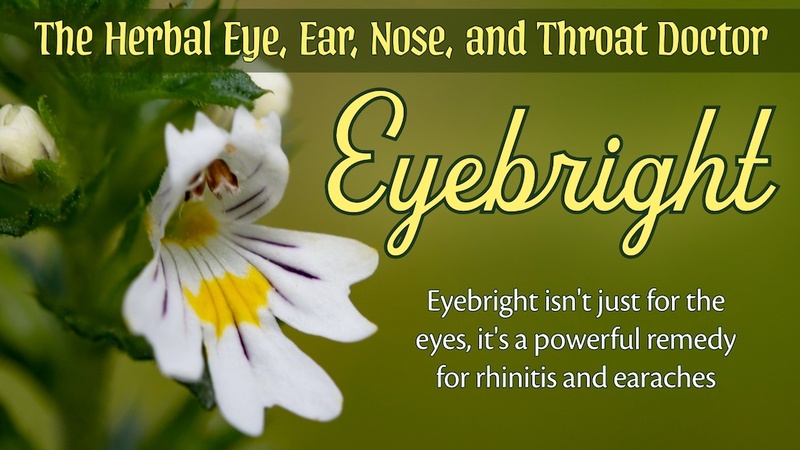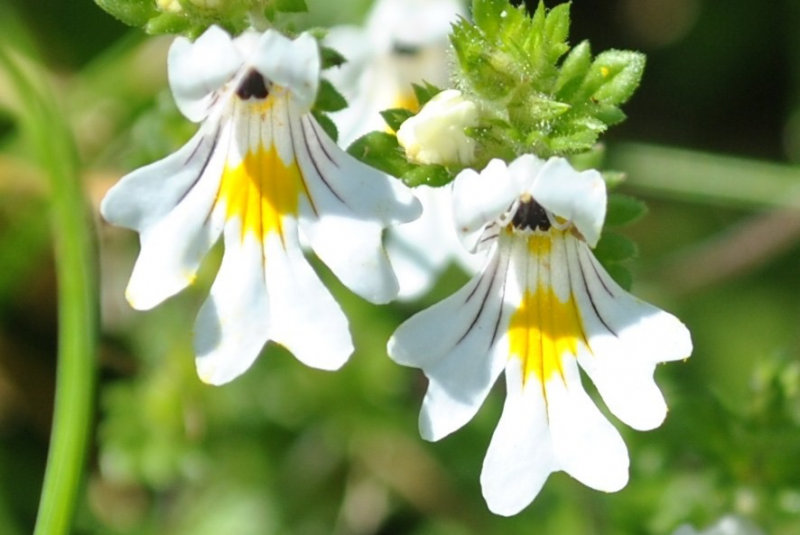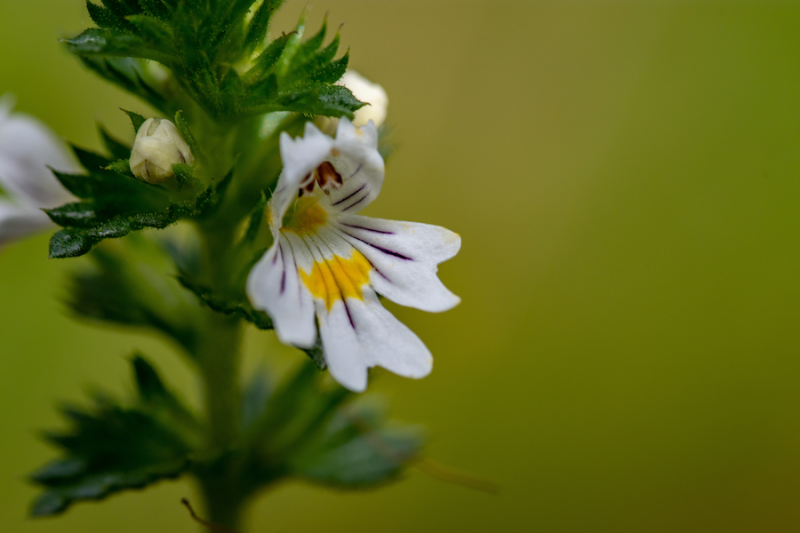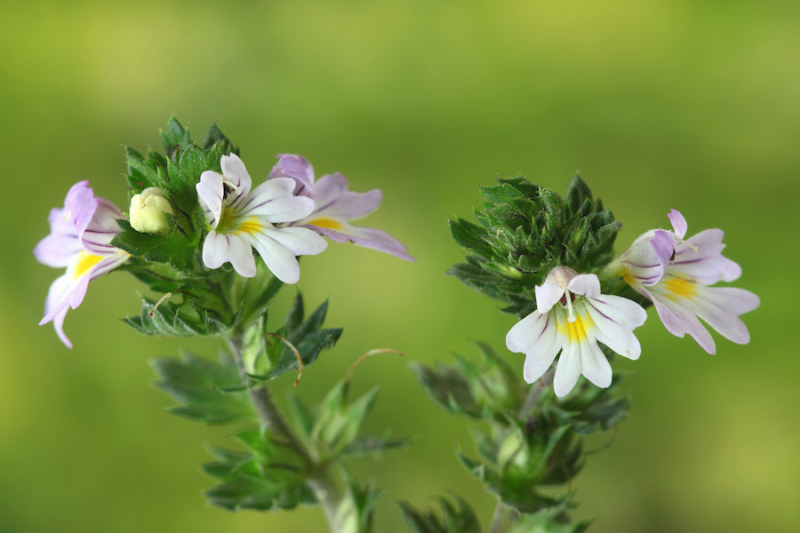
Spring is a cheery time with flowers and leaf buds adorning the trees and soon spring flowers popping up everywhere. Unfortunately, for many people, this is a miserable season due to hay fever, also known as seasonal allergic rhinitis. For these unfortunate souls, spring means a stuffed-up, itchy nose, red and watery eyes, and other unpleasant symptoms.
That’s why I’m discussing eyebright, which is one of the three main herbs I use to counteract respiratory allergies. Eyebright is one of those plants that has fallen victim to the narrow uses defined in commercial herbalism, where it is thought of primarily as a remedy for the eyes. To me, eyebright is more than just an eye remedy. To me, it's the herbal eye, ear, nose, and throat doctor.
Eyebright for the Eyes
 The use of eyebright for the eyes is based on the doctrine of signatures. Europeans saw a similarity between the colors and shape of the flowers and bloodshot eyes, so they started using the plant as an eyewash for eye diseases. Eyebright is an effective remedy for eye problems, but primarily when used as an eyewash.
The use of eyebright for the eyes is based on the doctrine of signatures. Europeans saw a similarity between the colors and shape of the flowers and bloodshot eyes, so they started using the plant as an eyewash for eye diseases. Eyebright is an effective remedy for eye problems, but primarily when used as an eyewash.
As a mild astringent, eyebright tea can be applied to the eyes as a wash or compress. This is useful in treating problems like bloodshot eyes, pink eye, conjunctivitis, and other inflammatory conditions. Eyebright helps these problems because it reduces inflammation, tones the eye tissues, and acts as a mild disinfectant.
The herbalist Dr. John Christopher made an eyewash formula using eyebright, bayberry, goldenseal, and red raspberry. His eyewash formula was reported to relieve eye irritations and infections, but it was also supposed to improve eyesight and help dissolve cataracts. I've heard some stories about people having success with this, but only when using the eyewash daily for a period of months. That requires a lot of determination! Taking the eyewash formula internally does not achieve the same results. Directions for making and using the herbal eyewash formula can be found in the book I co-authored with Thomas Easley, Modern Herbal Dispensatory.
Eyebright and Rhinitis
 Rhinitis is inflammation of the eyes, nose, and throat. Both eyebright and Christopher’s eyewash formula are helpful for easing rhinitis. This is because eyebright is helpful for thin, watery mucus secretions coupled with an itchy nose, and red, watery, irritated eyes. It’s also helpful for acute sinusitis with watery drainage, a drippy runny nose at the start of a cold, watery eyes, sneezing, post-nasal drip, sinus headache, and other upper respiratory symptoms.
Rhinitis is inflammation of the eyes, nose, and throat. Both eyebright and Christopher’s eyewash formula are helpful for easing rhinitis. This is because eyebright is helpful for thin, watery mucus secretions coupled with an itchy nose, and red, watery, irritated eyes. It’s also helpful for acute sinusitis with watery drainage, a drippy runny nose at the start of a cold, watery eyes, sneezing, post-nasal drip, sinus headache, and other upper respiratory symptoms.
I make an anti-allergy formula using three primary herbs—eyebright, nettles, and goldenrod. I've had great success using variations of this formula to help people who suffer from respiratory allergies. The directions for making one version of this formula can also be found in Modern Herbal Dispensatory. Also, If you’d like to learn more about remedies for rhinitis, hay fever, and chronic sinusitis check out the Sunshine Sharing Hour webinar I did on this topic, Unstuff Your Nose: Overcoming Allergies and Chronic Sinus Problems.
Eyebright and the Ears
 I learned about another use for eyebright from Herbalist David Winston. He called eyebright (particularly the fresh plant tincture) "herbal tubes in the ears." Eyebright can be helpful for children (or adults) who have problems with earaches due to swelling of the eustachian tubes. These are the tubes that go from the inner ear to the throat and allow the pressure on both of your ears to equalize. The equalization of pressure causes the pop in your ears when you change altitude suddenly,
I learned about another use for eyebright from Herbalist David Winston. He called eyebright (particularly the fresh plant tincture) "herbal tubes in the ears." Eyebright can be helpful for children (or adults) who have problems with earaches due to swelling of the eustachian tubes. These are the tubes that go from the inner ear to the throat and allow the pressure on both of your ears to equalize. The equalization of pressure causes the pop in your ears when you change altitude suddenly,
If these tubes become inflamed, they can swell shut, preventing the equalization of pressure. This causes earaches, which aren't necessarily infectious in nature. More often the irritation is an allergic reaction to wheat or dairy. This is why antibiotics are often worthless for treating earaches. The problem is a swollen eustachian tube, not an infection.
I experienced how painful this can be when I took a drive into the mountains many years ago. When we got to the top my ear wouldn't pop, and the pain became severe. We quickly drove to a lower elevation, which reduced, but didn’t completely eliminate, the pain. I went straight to my chiropractor, who did a procedure that opened the eustachian tubes and made my ear pop. Immediately, the pain was gone and did not come back.
Eyebright is the best herb I know of for reducing the allergic swelling of the eustachian tubes to both prevent and relieve earaches. I’ve used it many times, both on myself and my clients. It's very effective. You can give it daily to children who are prone to earaches or you can take a dropper full of the tincture every 15-20 minutes when you have an earache until the pain subsides, which usually takes one to two hours. I've also tried taking four capsules every hour and that also worked after the second dose.
So, as you can see, eyebright isn't just for the eyes. It helps the ears, nose, and throat as well. I hope you'll start thinking about it as the herbal eye, ear, nose, and throat doctor too.
Downloads
Steven's Articles
-

-
The Evidence for Berberine
A yellow alkaloid found in traditional infection-fighting…
-

-
The Sensible Use of Caffeinated Herbs
Kola nuts, guarana, and yerba mate and other herbs…
-

-
The Health Benefits and Problems with Coffee
This popular caffeinated beverage can be beneficial…
October
-

-
Understanding Caffeine & Cellular Adaptation
Preserving the power of caffeine's buzz and the…
September
-

-
Horseradish
A pungent spice for aiding protein metabolism…
-

-
Banaba or Crepe Myrtle
A beautiful tree from Southeast Asia whose leaves…
August
-

-
Monkeyflowers
Flower essences to help see ourselves more clearly…
-

-
Mariposa Lilies
Strengthening the bond between mother and child…
-

-
The Noble Bay Leaf
A common kitchen herb for aiding digestion and…
-

-
Epimedium: Horny Goat Weed
A circulatory stimulant and kidney yang tonic…
July
-

-
The Medicinal and Nutritional Benefits of Apricots
A nutritious fruit and valuable medicinal seed for coughs
-

-
Dogwoods
Asian dogwood is used to stop excessive discharge,…
June
-

-
Neem: The Village Pharmacy
A popular Ayurvedic remedy for dental and immune…
-

-
Spilanthes: The Toothache Plant
A traditional remedy for teeth and gums, as well…
-

-
Forsythia
An anti-inflammatory, fever-reducing, and infection fighting herb

